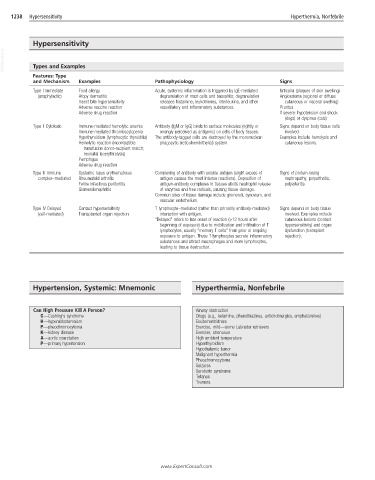Page 2486 - Cote clinical veterinary advisor dogs and cats 4th
P. 2486
1238 Hypersensitivity Hyperthermia, Nonfebrile
Hypersensitivity
VetBooks.ir Types and Examples
Features: Type
and Mechanism Examples Pathophysiology Signs
Type I Immediate Food allergy Acute, systemic inflammation is triggered by IgE-mediated Urticaria (plaques of skin swelling)
(anaphylactic) Atopy dermatitis degranulation of mast cells and basophils; degranulation Angioedema (regional or diffuse
Insect bite hypersensitivity releases histamine, leukotrienes, interleukins, and other cutaneous or visceral swelling)
Adverse vaccine reaction vasodilatory and inflammatory substances. Pruritus
Adverse drug reaction If severe: hypotension and shock
(dogs) or dyspnea (cats)
Type II Cytotoxic Immune-mediated hemolytic anemia Antibody (IgM or IgG) binds to surface molecules (rightly or Signs depend on body tissue cells
Immune-mediated thrombocytopenia wrongly perceived as antigenic) on cells of body tissues. involved.
Hypothyroidism (lymphocytic thyroiditis) The antibody-tagged cells are destroyed by the mononuclear- Examples include hemolysis and
Hemolytic reaction (incompatible phagocytic (reticuloendothelial) system. cutaneous lesions.
transfusion donor-recipient match;
neonatal isoerythrolysis)
Pemphigus
Adverse drug reaction
Type III Immune Systemic lupus erythematosus Complexing of antibody with soluble antigen (slight excess of Signs of protein-losing
complex–mediated Rheumatoid arthritis antigen causes the most intense reactions). Deposition of nephropathy, polyarthritis,
Feline infectious peritonitis antigen-antibody complexes in tissues elicits neutrophil release polyarteritis
Glomerulonephritis of enzymes and free radicals, causing tissue damage.
Common sites of tissue damage include glomeruli, synovium, and
vascular endothelium.
Type IV Delayed Contact hypersensitivity T lymphocyte–mediated (rather than primarily antibody-mediated) Signs depend on body tissue
(cell-mediated) Transplanted organ rejection interaction with antigen. involved. Examples include
“Delayed” refers to late onset of reaction (>12 hours after cutaneous lesions (contact
beginning of exposure) due to mobilization and infiltration of T hypersensitivity) and organ
lymphocytes, usually “memory T cells” from prior or ongoing dysfunction (transplant
exposure to antigen. These T lymphocytes secrete inflammatory rejection).
substances and attract macrophages and more lymphocytes,
leading to tissue destruction.
Hypertension, Systemic: Mnemonic Hyperthermia, Nonfebrile
Can High Pressure Kill A Person? Airway obstruction
C—Cushing’s syndrome Drugs (e.g., ketamine, phenothiazines, anticholinergics, amphetamines)
H—hyperaldosteronism Excitement/stress
P—pheochromocytoma Exercise, mild—some Labrador retrievers
K—kidney disease Exercise, strenuous
A—aortic coarctation High ambient temperature
P—primary hypertension Hyperthyroidism
Hypothalamic tumor
Malignant hyperthermia
Pheochromocytoma
Seizures
Serotonin syndrome
Tetanus
Tremors
www.ExpertConsult.com

